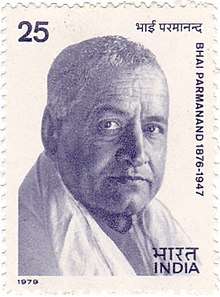Bhai Parmanand
Bhai Parmanand (4 November 1876 – 8 December 1947) was a Hindu nationalist[1], a prominent leader of the Hindu Mahasabha[2] and a leading member of Arya Samaj.[3] He was also one of the founders of Ghadar Party.[4] In 1908–09, he advocated partition of India along the religious lines.[2][5][6] Parmanand declared that followers of Hinduism and Islam in India were two different nations.[1][5][7] Parmanand specialized in writing popular literature in Urdu in which he emphasised that Hindus were true sons of India and Muslims were outsiders.[1]
Bhai Parmanand | |
|---|---|
 Parmanand on a 1979 stamp of India | |
| Born | 4 November 1876 |
| Died | December 8, 1947 (aged 71) |
| Citizenship | British subject (until 1947) Indian (from 1947) |
| Occupation | Vedic Missionary Politician |
| Political party | Hindu Mahasabha Ghadar party Arya Samaj |
In 1915, he was arrested by the British government in connection with Lahore Conspiracy Case and was later sentenced to death which was commuted to life imprisonment. He was imprisoned on the Andaman Islands till 1920, after which he was released.[8] He died of heart attack on 8 December 1947.[4]
Early life
Parmanand was born into a prominent family of the Punjab, Mohyal Brahmins.[9] His father, Tara Chand Mohyal, came from Kariala, Jhelum District and was an active religious missionary with the Arya Samaj movement.[4]
Political career
In October 1905, Parmanand visited South Africa and stayed with Mahatma Gandhi as a Vedic missionary.[4] Parmanand visited Guyana in 1910 which was the centre of the Arya Samaj movement in the Caribbean.[10]
Parmanand toured several British colonies in South America before rejoining Hardayal in San Francisco. He was one of the founder member of the Ghadar Party.[8] He accompanied Hardayal on a speaking tour to Portland in 1914 and wrote a book for the Ghadar Party called Tarikh-I-Hind. He returned to India as part of the Ghadar Conspiracy claiming he was accompanied by 5,000 Ghadarites. As one of the leaders of the Ghadar revolt, he was sent to promote the revolt in Peshawar. However, he was arrested in connection with the First Lahore Conspiracy Case and was sentenced to death in 1915. The sentence was later commuted to life imprisonment and he was imprisoned on the Andaman Islands and was subjected to hard labour until 1920. In protest against such harsh treatment of political prisoners, Bhai Parmanand went on hunger strike for two months. The King-Emperor, George V, released him in 1920 as the result of a general amnesty order.[11][8]
Partition of India
In 1908–09, Parmanand advocated partition of India along the religious lines.[2][5] He declared that followers of Hinduism and Islam in India were two different nations.[1][5][7] He called for total exchange of Hindu and Muslim population in two specific areas.[2] According to his plan elaborated, in his autobiography,
the territory beyond Sindh could be united with North-West Frontier Province into a great Musulman Kingdom. The Hindus of the region should come away, while at the same time the Musulmans in the rest of the country should go and settle in this territory.[12][13][14][2][4][1]
This preceded the Muslim League's Pakistan Resolution by over three decades.[4]
In the early years of the 20th century, Parmanand had also proposed partiton of Punjab province in order to save the Hindu minority from the Muslim majority in the province.[15]
Bhai Parmanand along with Rajnarayan Basu, Nabagopal Mitra and Vinayak Damodar Savarkar believed that religion was the most fundamental thing about people. National identity is based on faith of people. Therefore, Hindus and Muslims could not live together in India.[16]
Death
Parmanand died on 8 December 1947 of a heart attack. He was survived by his son Dr. Bhai Mahavir, a prominent member of the Jana Sangh and Bharatiya Janata Party.[4]
Legacy
An Institute of Business Studies was named after him in New Delhi,[17] a Public School in East Delhi and a hospital also in Delhi.
See also
- Partition of India
- Hindutva
- Ghadar Movement
- Two Nation Theory
References
- "Amit Shah,de facto PM, bulldozing history through statements on Partition". National Herald. 12 December 2019.
- "The art of Lying: The lies of Amit Shah on Two Nation Theory". Medium.com. 4 January 2020.
- "Poetry and partition". Greater Kashmir. 14 March 2015.
- "Bhai Parmanand". The Arya Samaj. Retrieved 12 July 2020.
- Nair, Neeti (1 April 2011). Changing Homelands: Hindu Politics and the Partition of India. Harvard University Press. p. 174.
Not only in 1947, but on numerous occasions earlier, Mahasabha leaders like Parmanand and Moonje had proposed partiton as one possible solution. In fact, Parmanand claimed that Hindus and Muslims constituted two nations
- "CAA, NRC will complete divide & rule agenda". Deccan Chronicle. 22 December 2019.
- "Hindutva: theory and practice". Greater Kashmir. 17 October 2018.
- "Bhai Paramanand biography, age, family, birthday & more". Mythicalindia.com. Retrieved 13 July 2020.
- Singh, Fauja (1972). Eminent Freedom Fighters of Punjab. Punjabi University, Dept. of Punjab Historical Studies.
- Lal, Prita (1 May 2005). "Arya Spiritual Center". Hinduism Here. Archived from the original on 14 February 2006. Retrieved 30 August 2008.
- Singh, Jaspal. "Historical Sikh Events: History of the Ghadar Movement part 3 – Return to India". All About Sikhs. Retrieved 5 August 2008.
- Parmanand, Bhai. The Story of my Life. pp. 41–.
- "Hindus- Muslims in 1857 & Emergence of 2 Nation Theory". Shamsul Islam. Retrieved 19 May 2007. Cite journal requires
|journal=(help) - Jaffrelot, Christophe (2009). Hindu Nationalism: A Reader. Princeton University Press. pp. 193–. ISBN 1-4008-2803-1.
- Jaffrelot, Christophe (30 December 2002). "The Germination Of Insecurity". Outlook India.
- "With the Citizenship Bill, India just took a turn to becoming a religion-based State". Economic Times. 10 January 2019.
- Bhai Parmanand. Institute of Business Studies
Further reading
- The Story of My Life by Bhai Parmanand, translated by N. Sundra Iyer and Lal Chand, The Central Hindu Yuvak Sabha, Lahore, 1934
